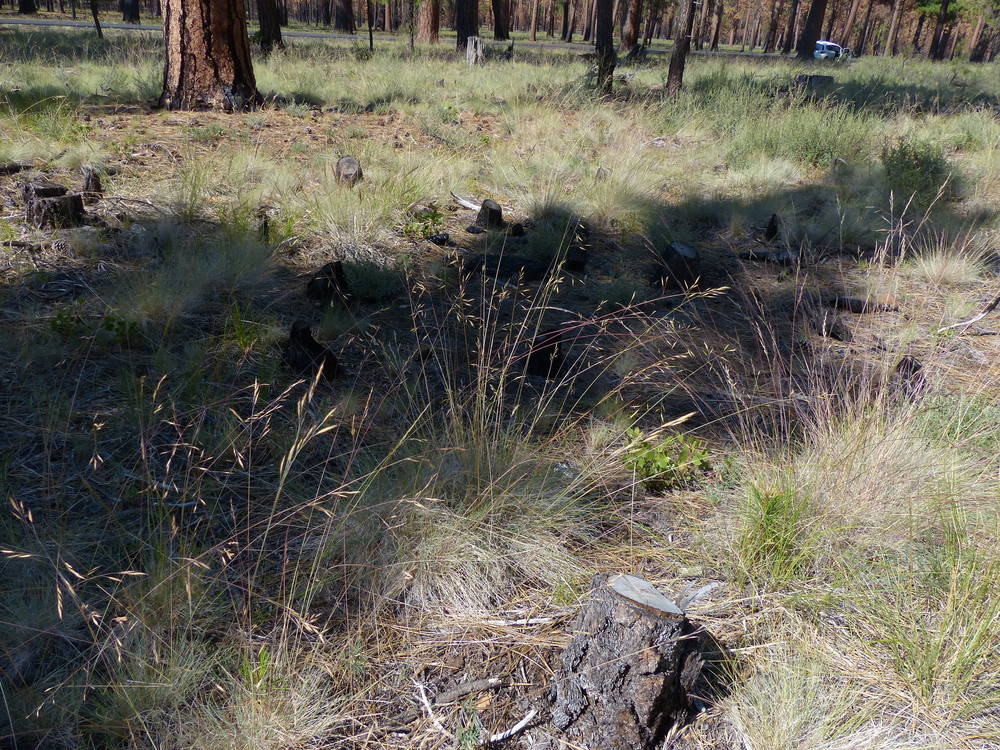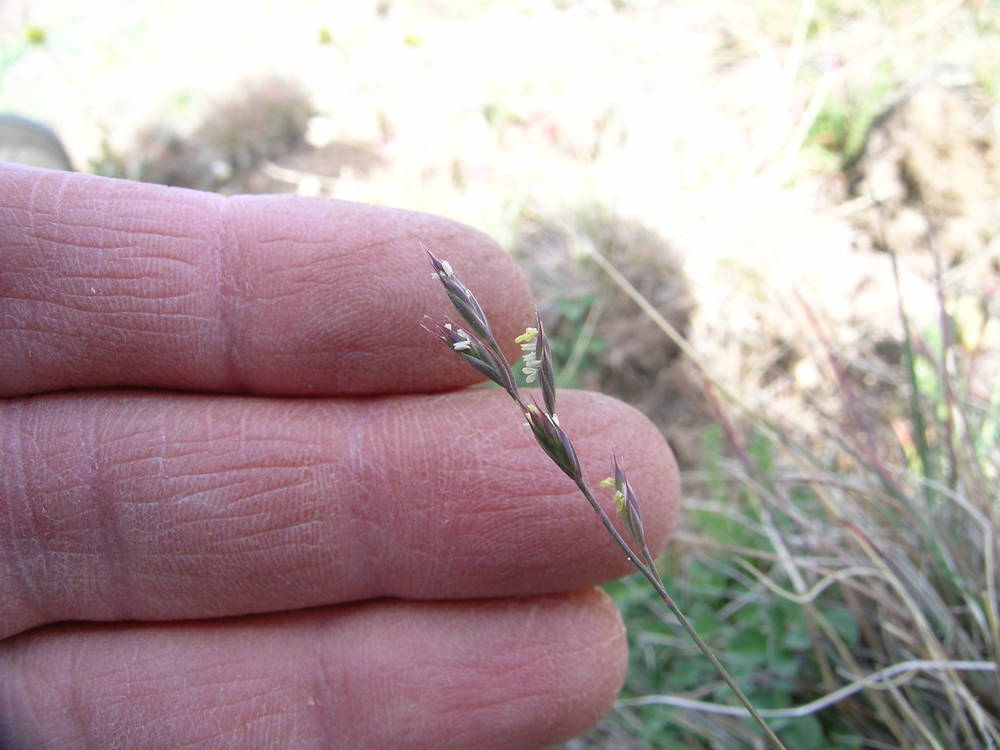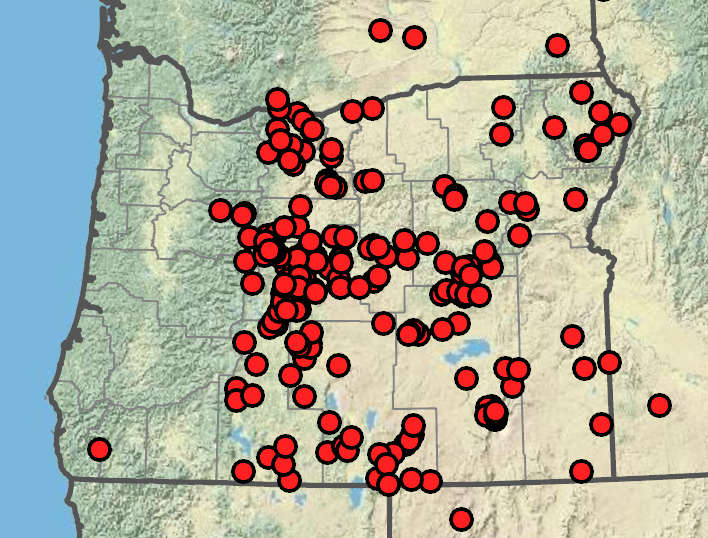Festuca idahoensis
Festuca
Idaho fescue
fescue
basal branching intravaginal.
glabrous or sometimes scabrous or pubescent below the inflorescence;
basal branching intra- or extravaginal.
mostly basal;
sheaths open, glabrous to hairy, usually pale (white, pink, light brown) and lacking contrasting veins, crumbling or somewhat splitting between the veins but not shredding;
blades readily spinning between the fingers;
collars glabrous;
ligules 0.3–0.6 mm;
blades (5)8– 25(35)cm × 0.3–1 mm as folded, conduplicate, usually glaucous, sometimes green;
outer surface scabrous, sometimes with long hairs;
inner surface with hairs about as long as the leaf is thick; flag leaves (1.5)3–7(9.5) cm, usually conduplicate, sometimes loosely rolled.
sheaths open or closed;
auricles distinct upright flaps or absent;
ligules membranous, usually ciliate;
blades flat, folded, conduplicate or involute, glabrous, scabrous or pubescent or glaucous.
s (5)7– 12(20) cm; open at anthesis; lowest node with 1–2 branches;
branches (5.8)7.5–17(19)mm, ascending to reflexed at anthesis, appressed after anthesis or the lower branches sometimes remaining spreading to reflexed.
open or contracted panicles, occasionally reduced to racemes;
branches erect early in development, spreading to reflexed at flowering time and often returning to a nearly upright position after flowering.
(5.8)7.5–17(19)mm, with (2)3–7(9) florets.
laterally compressed; (1)2–10 florets; most bisexual but upper spikelets reduced or aborted;
disarticulation above the glumes; beneath the florets.
glabrous or hairy at the tips only;
lower glumes (2.5)3–5(6)mm, 1–3-veined;
upper glumes (3)4–8 mm, 3–4-veined.
2, usually exceeded by the florets; ovate to lanceolate; acute to acuminate;
lower glumes 1(3)-veined;
upper glumes 3(5)-veined.
4–4.5 mm, glabrous.
glabrous or sometimes minutely hairy at the tip.
apex glabrous.
cross sections 0.35–0.6 × 0.55– 0.7 mm; more or less round or hexagonal;
veins (4)5(6);
ribs (1)3(5); dorsal sclerenchyma in broad bands more than twice as wide as thick, occasionally continuous.
(5.8)6–8(10)mm, 0(1)-veined;
hairs on the distal part only;
lemma awns (1)2–6(7) mm; shorter than to occasionally equaling the lemma body.
membranous to leathery, generally keeled near the tip, 5(7)-veined;
tips acute to attenuate, often minutely 2-toothed, usually awned;
lemma awns; if present; terminal or subterminal; straight.
(2.5)3.2–4(4.5) mm.
3.
usually wider than long, glabrous; smooth; but sometimes elongated and/or pubescent.
=28.
Festuca idahoensis
Festuca
Prairie, grassland, shrub-steppe, open pine forest, often in partial shade or on north-facing slopes; also on south-facing slopes in subalpine and alpine zones. 100–3000 m. BR, BW, Casc, Col, ECas, Lava, Owy. CA, ID, NV, WA; north to British Columbia, northeast to Saskatchewan, SD, and NM. Native.
Festuca idahoensis is the most common fine-leaved fescue east of the Cascades. However, very similar fescues have been introduced. Festuca trachyphylla and F. valesiaca, planted on roadsides and used to renovate dry pastures, have shorter lemmas and denser inflorescences. Robust individuals of F. occidentalis can be similar to F. idahoensis, but in F. occidentalis many of the lemma awns are longer than the lemmas. In alpine sites, F. idahoensis can be confused with F. brachyphylla and F. saximontana, which have shorter lemmas. Plants west of the crest of the Cascades that were once included in F. idahoensis are now recognized as a distinct species, F. roemeri, which has broader leaves than F. idahoensis.
Temperate, arctic, and alpine regions worldwide. Approximately 450 species; 15 species treated in Flora.
Taxonomy of some taxa in this genus is controversial because of the diversity of species that look very similar but differ consistently in cryptic traits like ovary pubescence or leaf anatomy, or in habitat. The most severe problems involve the fine-leaved fescues, which have narrow, folded, mostly basal leaves. Some species formerly considered members of the genus Festuca have been placed in other genera. Tall and meadow fescues (formerly F. arundinacea and F. pratensis) are more closely related to Lolium than to Festuca and have been moved to their own genus, Schedonorus. The peculiar spike fescue (formerly F. kingii) is currently placed in the genus Leucopoa. Annual fescues with long, gradually tapered awns are now treated as Vulpia, but they may be returned to Festuca at some point. Vulpia species occasionally hybridize with fine-leaved fescues, mainly F. rubra. When keying Festuca, lemma length is measured on the lowest floret of the spikelet, at or after anthesis. Lemma and spikelet lengths exclude awns. Assess leaf sheath closure on the second-from-the-top leaf of a vegetative shoot, not on culm leaves. In some fescues, such as F. rubra, the pale leaf sheaths soon dry out and die between the veins, leaving shredding, brown, somewhat shiny sheaths with contrasting white veins. In others, such as F. idahoensis, the pale leaf sheaths remain pale and intact, sometimes crumbling or cracking a bit, only belatedly dying and shredding. In circumstances in which their old sheaths remain in place, they might be confused with the first group except that the dead, brown leaves are obviously old, usually attached to dead or dying blades.
Barbara Wilson, Richard Brainerd, Nick Otting
Barbara Wilson, Richard Brainerd, Nick Otting
- Local floras:
BC,
CA,
OR,
WA
- Local Web sites:
CalFlora,
CalPhotos,
Flora NW,
PNW Herbaria
WildflowerSearch
iNaturalist (observations)
USDA Plants Database
- LBJ Wildflower Center
- SEINet
- Plants of the World Online
- Encyclopedia of Life
- Wikipedia
- Google Image Search
- Local floras:
CA,
OR,
WA
- Local Web sites:
CalFlora,
CalPhotos,
Flora NW,
PNW Herbaria
WildflowerSearch
iNaturalist (observations)
USDA Plants Database
- LBJ Wildflower Center
- SEINet
- Plants of the World Online
- Encyclopedia of Life
- Wikipedia
- Google Image Search




